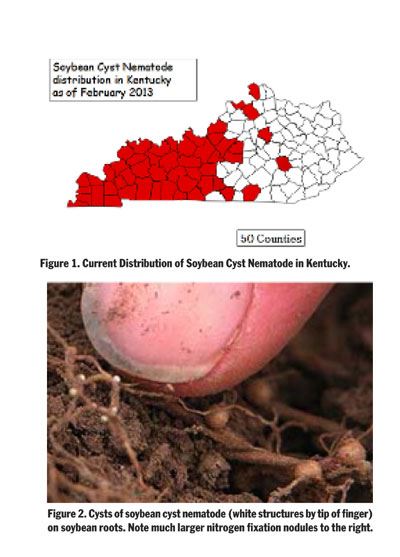It Is Not Too Late To Sample Fields For Soybean Cyst Nematode
PRINCETON, KY.
Soybean cyst nematode (SCN) is the most widespread (Figure 1) and damaging disease pest of soybean in Kentucky. It is my opinion that SCN is the main cause of the so-called, “yield ceiling” that is evident in many Kentucky soybean fields.
SCN (Figure 2) is managed by rotating fields to non-host crops, such as corn, and by planting soybean cultivars that resist SCN. The problem is that in order for these tactics to be used properly, their effectiveness must be monitored over time. For example, some SCN-resistant cultivars do not resist SCN as well as other cultivars. In addition, how SCN populations respond to a year in corn can be highly variable, depending on the field and the year. The bottom line is that you cannot just implement SCN control measures and then expect them to work with little to no oversight.

The best way to keep tabs on how different management practices are impacting SCN is to periodically monitor SCN populations in fields. Sampling once every four years is ideal. This will allow you to identify fields where adjustments need to be made, such as planting a different SCN resistant cultivar. However, because SCN rarely causes symptoms to develop in fields – even when substantial yield loss is occurring- it is very easy to pass over SCN as a reason why a field may not be yielding as well as you think it should. Unfortunately, few soybean producers in KY sample their fields for SCN, even though the cost of analysis ($10/sample) is paid for by the Kentucky Soybean Promotion Board and has been for many years. Many growers have never had any of their fields checked for SCN infestation or fields were tested many years, perhaps decades, ago.
Although fall is the ideal time to sample fields for SCN for a variety of reasons (mostly logistical), sampling fields anytime before planting can provide helpful information. Generally, fields targeted for SCN sampling in the spring are the ones that will be planted to soybean. Results of SCN soil analysis tests conducted now may not come soon enough for you do anything different this spring, but it will get you started on a regular SCN sampling regime. SCN and soil fertility samples can usually be based on the same sample, with the sample being split. For more information on how to collect and submit SCN soil samples, please look on-line at the below link, or stop by your local county Extension office for more information.
http://www.ca.uky.edu/agcollege/plantpathology/ext_files/PPFShtml/PPFS-AG-S-9.pdf Δ
DR. DON HERSHMAN: Extension Plant Pathologist, University of Kentucky